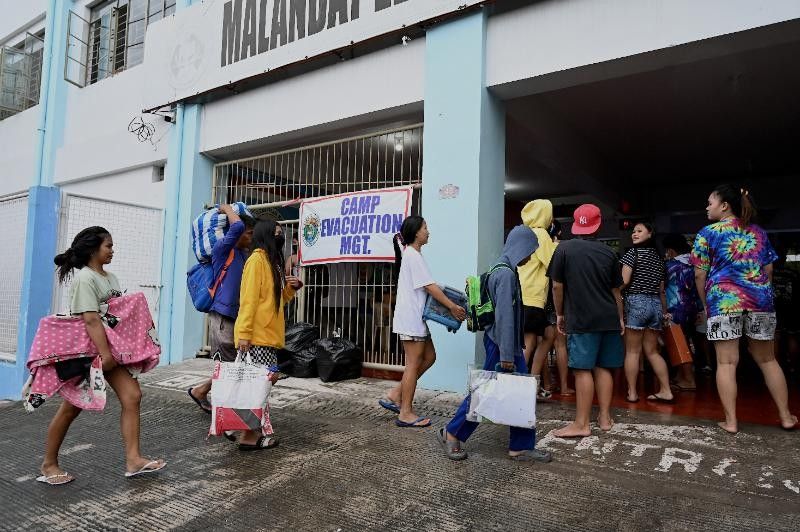Why the Philippines needs to stop using schools as evacuation centers

MANILA, Philippines — Lights out: Chairs moved to the side, handwoven mats with thin sheets laid on the floor, and almost all classrooms packed with families coming from different areas.
This is the usual scenario in Philippine public schools when a typhoon is forecast to make landfall in the country. These schools provide temporary shelters that vulnerable sectors living in areas that are at high risk of flooding and storm surge need.
According to state weather bureau PAGASA, an average of 20 tropical cyclones enter the Philippines, eight or nine of which make landfall. During the peak season from July to October, 70% of tropical cyclones develop into typhoons.
As of 2019, the country recorded having 28,083 evacuation centers. Of these, 10,262 are multi-purpose halls, gymnasiums, covered courts, municipal halls, churches, and health centers. The rest, or 63%, of the evacuation centers are schools, ranging from day care centers to full universities.
While schools become the usual sites for shelter for several days or weeks during typhoons, some environmental experts think that the country must step back in using them because severe climate phenomena, such as typhoons, continue to strengthen in the Philippines.
According to Arlen Ancheta, a professor at the University of Santo Tomas specializing in environmental science, Filipinos have grown used to using schools as temporary shelters because natural hazards did not use to be as intense and destructive and people only needed to seek shelter for a day or two.
"With the severity of flooding and precipitation [that comes with] more rainfall, you really cannot foresee the stopping of floods or rains," Ancheta said, adding that the government should prioritize evacuation centers for the safety and long-term use, especially of those belonging to the vulnerable sectors.
Ancheta’s colleague Moises Norman Garcia, whose research interests include environmental education and literacy, agrees. For him, having destructive typhoons battering the country yearly seems to have become the new norm.
"So definitely, the evacuation centers will [be filled] during the time when more people will be seeking them," Garcia said.
He noted that the schools in urbanized areas in the Philippines have sturdy structures but that is still not the case in some provinces.
Both experts agreed that the government must construct evacuation centers separate from schools because the current situation affects the children's quality of education. This becomes further highlighted when classes need to start but the evacuees are still stuck in classrooms because either the flood has not receded or that their barangay—a small administrative district—is still devastated by the typhoon.
"The children can't go back to school because some families still stay there because of flooding. So classes do end up being disrupted," Ancheta said, adding that this leads to a domino effect where the disaster impacts not just the evacuees but students as well.
The experts' sentiments are directly experienced by Danielle Atendido who is a secondary public school teacher in Infanta, Quezon in southern Luzon.
"There was a time when the evacuees needed to use the paper modules to make fire to cook," Atendido said, adding that the evacuees used up the school's sanitary supplies like alcohol. "More often than not, the rooms are left [dirty] when the evacuees leave."
After evacuees go back to their homes, Atendido and her co-faculty members assess the classroom's conditions and if ever there are broken facilities, they immediately report it to the school head.
"Sometimes, the barangay officials clean the classrooms but oftentimes, we [teachers] do the cleaning," she added.
Atendido adds that using schools as temporary shelters further affects the quality of education because it is difficult to foresee how many days the classrooms will be used as shelter.
"This means that there is a high chance that the students would not meet the competency level that they need," she said. "This is harmful for the students especially because in-person classes have resumed now after a two-year lull due to the pandemic."
"When it comes to national tests, the students are already at a disadvantage because there are lessons that weren't covered due to reduced school days," Atendido said, adding that sometimes, the students themselves end up cleaning the rooms themselves.
This problem of schools being excessively used for evacuation centers has not escaped the eyes of the government. In the budget deliberation of the Department of Education in the Senate last September, 2022, Vice President Sara Duterte, who is also education secretary, said that classrooms can be used as evacuation centers for up to 15 days only, according to guidelines that she released last September.
"[Local government units] should not use schools as long-term shelters for evacuees," the department order reads.
'Resilient, inclusive, and sustainable'
If the country distances itself from using classrooms as evacuation sites, then the government would have to build shelters that evacuees can use.
For Ancheta, future evacuation centers must be open to all, especially for women, children, and the elderly. She added evacuation centers would be best built where there are access roads for eas of food and water distribution.
"And then, of course, we have to do some geographical mapping, where we have to consider the river system. Such evacuation centers have to be far from the river system because if a river overflows, it will be flooded," she said, emphasizing that, if possible, the government can build two-storey buildings so evacuees have a second floor to go to in case of bad flooding.
For Garcia, both the national and local government must have enough budget for the construction of several evacuation centers and they should build it in uphill areas to avoid flooding. The focus should be on "building back better" which refers to building stronger and quite resistant or resilient evacuation centers, Garcia added.
"I do believe in the public-private partnership. If the businessmen are sincere, they can help the government build evacuation centers," Garcia said.
-- This story was supported by Climate Tracker Asia and Earth Journalism Network
Siegfred Lacerna is a graduate of the UST Journalism School.
- Latest




























